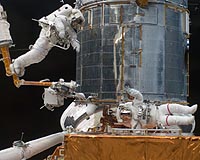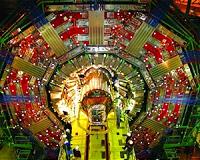|
 Flying By Titan And Dione Makes For Some Nice Views
Flying By Titan And Dione Makes For Some Nice ViewsPasadena CA (JPL) Apr 05, 2010 In a special double flyby early next week, NASA's Cassini spacecraft will visit Saturn's moons Titan and Dione within a period of about a day and a half, with no maneuvers in between. A fortuitous cosmic alignment allows Cassini to attempt this doubleheader, and the interest in swinging by Dione influenced the design of its extended mission. The Titan flyby, planned for Monday, April 5, will take Cassini to within about 7,500 kilometers (4,700 miles) of the moon's surface. The distance is relative ... read more |
. |
|
|
Free Space, Earth, Energy And Military Newsletters - Delivered Daily |
| . | . |
| .. |
Cosmos has billions more stars than thought Paris (AFP) March 24, 2010
Paris (AFP) March 24, 2010Astronomers may have underestimated the tally of galaxies in some parts of the Universe by as much as 90 percent, according to a study reported on Wednesday in Nature, the weekly British science journal. Surveys of the cosmos are based on a signature of ultraviolet light that turns out to be a poor indicator of what's out there, its authors say. In the case of very distant, old galaxies, ... more Hubble Confirms Cosmic Acceleration With Weak Lensing  Leiden, Holland (ESA) Mar 26, 2010
Leiden, Holland (ESA) Mar 26, 2010A new study led by European scientists presents the most comprehensive analysis of data from the most ambitious survey ever undertaken by the NASA/ESA Hubble Space Telescope. These researchers have, for the first time ever, used Hubble data to probe the effects of the natural gravitational "weak lenses" in space and characterise the expansion of the Universe. A group of astronomers [1], le ... more Black Holes Gain Weight And Light Up during Galaxy Collisions  Manoa HI (SPX) Mar 26, 2010
Manoa HI (SPX) Mar 26, 2010Giant black holes in the centers of galaxies grow mainly as a result of intergalactic collisions, according to results presented by a group of astronomers led by Dr. Ezequiel Treister from the University of Hawaii, published in the March 25th issue of the international journal Science. As gas clouds in galaxies are sucked into the central black hole, they emit vast amounts of radiation, gi ... more |
.. |
 Zen And The Art Of Space Maintenance  World's Largest Particle Collider May Unlock Secrets Of Universe  Instant online solar energy quotes Solar Energy Solutions from ABC Solar |
.. |
|
|
Free Space, Earth, Energy And Military Newsletters - Delivered Daily |
|
|
. |
 Another type of proto-human discovered
Another type of proto-human discoveredLeipzig, Germany (UPI) Mar 24, 2009 European researchers say they have identified a previously unknown species of proto-human that existed at least 1 million years until about 40,000 years ago. The species left Africa about 1 million years ago and migrated as far as southern Siberia before it disappeared, the researchers said in a study published Wednesday in the scientific journal Nature. The conclusion was based on DNA analysis performed on a small bone fragment, excavated in a cave, that was the only physical remains of the sp ... read more |
| The contents herein, unless otherwise known to be public domain, are Copyright 1995-2010 - SpaceDaily. AFP and UPI Wire Stories are copyright Agence France-Presse and United Press International. ESA Portal Reports are copyright European Space Agency. All NASA sourced material is public domain. Additional copyrights may apply in whole or part to other bona fide parties. Advertising does not imply endorsement, agreement or approval of any opinions, statements or information provided by SpaceDaily on any web page published or hosted by SpaceDaily. Privacy statement |
| Previous Issues | Apr 02 | Apr 01 | Mar 31 | Mar 30 | Mar 29 |